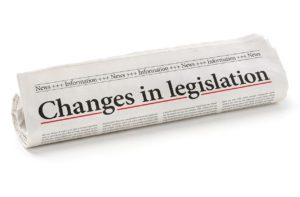
On December 29, 2022, President Biden signed into law the Consolidated Appropriations Act, 2023 which includes a “SECURE Act 2.0 update” retirement reform legislation (The Act). Below we expand on some of the provisions, providing descriptions and effective dates as they are known today. SECURE 2.0 contained over 90 provisions. This is not meant to be a comprehensive list, and there are more provisions not covered here. However, we believe the items outlined below will be of most interest to retirement plan sponsors.
Some of the provisions become effective immediately, while others will become effective in future years. Note that the information is organized in the order that the provisions become effective, starting with those that have retroactive effective dates. Each section is broken down into what is required by the SECURE 2.0 Act and what are optional changes that can be made if desired for your participants.
Retroactively Effective: Secure Act 2.0 Update
Optional
- Effective after January 26, 2021, a retirement plan or IRA may permit a qualified disaster recovery distribution of up to $22,000 if made within 180 days after the first day of the incident period applicable to a qualified disaster if the individual’s principal place of residence is within the qualified disaster area and the individual has sustained economic loss due to the qualified disaster. This distribution is not subject to the 10% early withdrawal penalty tax, is taxed over 3 years, and can be repaid within 3 years.
Effective in 2022: Secure Act 2.0 Update
Mandatory
- No mandatory changes are effective in 2022.
Optional
- Secure 2.0 expands the IRS correction program known as EPCRS to allow more types of errors to be corrected through a self-correction process and to expand the program to IRA failures. Under SECURE 2.0, most inadvertent errors are eligible for self-correction if (i) substantially corrected before the error is identified by the IRS on audit and (ii) corrected within a reasonable period of time after the failure is identified. The IRS is directed to update EPCRS consistently with this provision within two years of enactment of the Act.
- Distributions to an employee who is a “terminally ill individual” are not subject to the 10% early withdrawal penalty tax and can be repaid in 3 years. This provision does not create a new distribution right under retirement plans, so a participant would need to be eligible for a distribution under an existing rule.
- Employees may designate employer contributions (matching or non-elective) as Roth contributions.
Effective in 2023: Secure Act 2.0 Update
Mandatory
- The required beginning date (RBD) for a required minimum distribution (RMD) is age 73 beginning in 2023, and age 75 beginning in 2033. If you are age 72 before 2023, your RBD is 72. If you turn age 73 before 2033, your RBD is 73. If you are age 74 after 2032 your RBD is age 75.
- The excise tax for failure to take an RMD is reduced from 50% to 25%. For taxpayers who take the RMD before an IRS audit or (if earlier) the second year in which the excise tax is imposed, it is reduced further down to 10%.
Optional
- Employers will be allowed to give de minimis financial incentives to employees who elect to have deferrals made. This cannot be paid for by the plan. De minimis is not defined specifically but gift cards were referred to.
- The Secure Act 2.0 update removes the substantiation requirement for hardship withdrawals and allows a plan administrator to rely on the employee’s written self-certification that (i) the circumstances for the hardship exist, (ii) the amount requested is not more than the amount required to satisfy the financial need, and (iii) the employee has no alternative reasonably available means to satisfy such need. Reliance on self-certification is NOT permitted if the plan administrator has actual knowledge that is contrary to the employee’s certification.
- The previous credit under SECURE 1.0 for small employer plan startup costs will be increasing from 50% to 100% up to $5,000 if the plan sponsor has less than 51 employees.
- The SECURE Act 2.0 update also provides a new credit related to employer contributions of up to $1,000 per employee with a phase out for employers who have between 50 and 100 employees. Employers cannot include employees making more than $100,000 in that count. There is no deduction for employer contributions that qualify for a credit. This contribution is phased out over 4 years.
Effective in 2024: Secure Act 2.0 Update
Mandatory
- Pre-death RMDs will no longer be required from Roth accounts in a 401k plan. This will now mirror the IRA withdrawal requirements already in place.
- Catch-up contributions for all participants whose wages exceed $145,000 (indexed) for the preceding calendar year will be required to be designated Roth contributions. Some employers may have to choose to add Roth or discontinue catch-up contributions.
- Surviving spouses will be allowed the irrevocable right to elect to be treated as the deceased employee for purposes of the RMD rules. This will allow some spouses greater flexibility in setting up their RMDs.
- Community property rules for ownership under controlled and affiliated service groups will be disregarded. Community property rules will remain in place for determination of highly compensated employee and Key employee status.
- Under SECURE 1.0, long-term part-time employees must be allowed to defer if they have worked more than 500 hours in 2021, 2022 and 2023. They are not required to receive employer contributions.
Optional
- Top heavy plans will no longer be required to provide top heavy minimums, generally 3% of annual compensation, to employees who have not worked a year of service and are not age 21.
- A distribution that qualifies as an emergency personal expense distribution will not be subject to the 10% early distribution penalty tax. Only one emergency distribution will be permitted per calendar year, which cannot exceed the lesser of (i) $1,000 or (ii) the employee’s vested account in excess of $1,000. The plan administrator may rely on the individual’s certification. No further emergency distributions are permissible during the three-year repayment period unless repayment occurs (or subsequent employee deferrals equal the amount of the distribution).
- Employers may increase the automatic cash out limit from $5,000 to $7,000. This will allow employers to require terminated employees with balances under that limit to remove their balances from the plan or they will be automatically distributed, generally to a default IRA.
- Employers will be allowed to contract with a service provider that will automatically transfer a default IRA to a participant’s new employer-sponsored retirement plan, unless the participant elects otherwise.
- A victim of domestic abuse may request a withdrawal in the amount of the lesser of $10,000 or 50% of their vested balance. The withdrawal is not subject to the 10% early distribution penalty and may be recontributed to the plan.
- Employers will be allowed to match student loan payments as if those payments were elective deferrals.
- Employers may offer pension-linked emergency savings accounts to non-highly compensated employees. Employees may be automatically enrolled in the account at up to 3% of their salary. Contributions may not exceed $2,500. Contributions are post-tax and are treated as deferrals for matching purposes. Withdrawals need to be allowed monthly and are not subject to the 10% premature distribution penalty. The first 4 withdrawals in a year may not be subject to any fees.
- The Act allows a SIMPLE IRA plan to be replaced with a 401k plan during the plan year.
Effective in 2025: Secure Act 2.0 Update
Mandatory
- All 401(k) plans adopted after December 29, 2022, must begin automatic enrollment and auto escalation in 2025. Automatic enrollment must start at a minimum of 3%, and annual automatic escalation must increase to at least 10% (1% per year) but not more than 15%.
- The Secure Act 2.0 update reduces the requirement for a plan to offer a long-term part-time employee the ability to defer into the retirement plan from 3 consecutive years with at least 500 hours of service down to 2 consecutive years of 500 hours of service. If someone has worked 500 hours in 2023 and 2024, they must be allowed to defer starting in 2025. They are not required to receive employer contributions.
- The catch-up limit for the years in which the participant attains ages 60, 61, 62, and 63 must be increased if the plan allows for catch ups. The increased limit is the greater of (i) $10,000 (indexed after 2025) or (ii) an amount equal to 150% of the normal catch-up limit for 2024.
Optional
- Distributions up to $2,500 a year for the payment of premiums for certain long-term care premiums can be allowed.
More guidance will be needed on the process of employing several of these provisions. Recordkeeping vendors will have system changes to be made, and of course plans will need to be amended. Rest assured that the SECURE Act 2.0 update will continue to be a discussion point for plan sponsors and the service providers that work on their plans. ML&R Wealth Management is here to assist you with guidance and assistance in navigating SECURE 2.0 and all of your other retirement plan questions.



